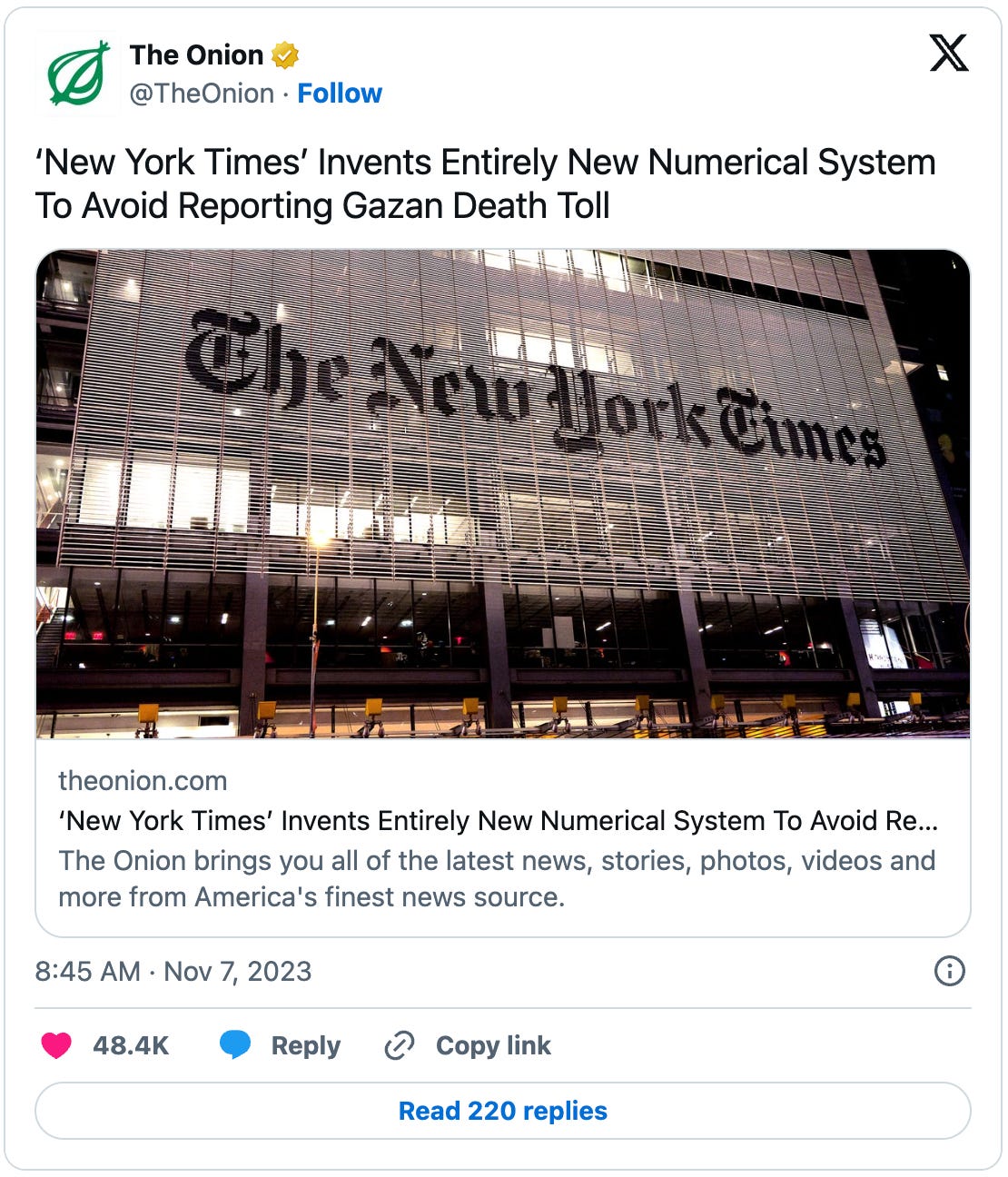“Israel Rescues 4 Hostages in Military Operation; Gazan Officials Say Scores Are Killed,” reads a New York Times headline from Saturday.
It’s a very odd-looking headline even if you don’t know anything about the propagandistic tactics being employed in it. The first half is very clear, while the second half is unintelligible and reads like some weird kind of riddle or word puzzle.
The New York Times is performing these bizarre, cryptic linguistic gymnastics to discuss the latest Israeli massacre in Gaza which as of this writing has a reported death toll of 236.
Right off the bat we can see something weird in this headline with the use of the word “scores” to describe the number of people reported killed in the massacre. The New York Times article itself says it was reported that “more than 200 people were killed in central Gaza,” so the correct quantifier for the headline would be “hundreds”, not “scores”. This would be like a headline saying “dozens” of people were killed on 9/11 instead of “thousands”; it would technically be correct since the number of people killed were mathematically speaking many many dozens, but it would give readers the wrong impression of the lethality of the incident.
 https://x.com/TameeOliveFern/status/1799525189828649351
https://x.com/TameeOliveFern/status/1799525189828649351
Next, notice the sudden switch mid-headline from active, certain voice to passive, doubtful voice. Four Israeli hostages were definitely rescued by Israel, while Gazan officials are alleging that scores were killed.
Scores of what? Cats? Chickens? Israelis?
Killed by what? Salmonella poisoning? Traffic accidents? Congolese militias?
There’s no way to tell from the headline.
The mass media in general and The New York Times in particular are notorious for their passive language “Palestinian child ceases breathing after encountering bullet” headlines when promoting Israeli information interests, but it really drives the point home when you see it switch from normal human language to something that sounds like a clue The Riddler would leave Batman within the very same headline.
And what’s interesting is that nothing The New York Times editors did here is technically a lie. Every word they meticulously selected for their headline is technically true, but it is shaped in such a way that it draws the reader’s attention away from the fact that Israel just massacred hundreds of human beings.
They could have just as easily written “Israel Kills Hundreds of Palestinians in Central Gaza Attack; 4 Hostages Rescued” and it would have been just as true, but then public attention would have been drawn in the opposite direction. The New York Times never, ever draws public attention in that direction; the slanting only ever goes one way.
 https://x.com/ryangrim/status/1798799983447048303
https://x.com/ryangrim/status/1798799983447048303
We saw something similar the other day from The New York Times when they reported that Israel has been torturing Palestinian prisoners by sodomizing them with hot metal rods — sometimes to death — but buried this information at the very bottom of the article, without mentioning a word of it in the headline or sub-headline.
Here again, nobody can technically accuse The New York Times of lying; they didn’t report anything that wasn’t true or fail to report anything that was true. They just drastically underemphasized the real story in their report to direct their readers’ attention away from Israeli criminality.
A lot of people who grow skeptical of the mass media correctly assume that these outlets are propaganda services for the US empire, but incorrectly assume that this means they must be lying all the time. In truth the imperial propaganda machine is much more sophisticated than this, and much more effective.
Rather than making up whole-cloth lies and losing all credibility in the mainstream public, the mass media will generally rely on distortions like the above which skew public perception without actually technically lying. They’ll place emphasis in areas which benefit the empire, they’ll omit inconvenient facts, they’ll use tricky phrasing, they’ll uncritically report on the claims of favored government officials while saying the claims of unfavored government officials are made without evidence, they’ll mention convenient news stories over and over again, and they’ll report inconvenient stories only once before leaving them to get lost in the daily news churn.
I actually cite the mass media quite a bit in my own work, because a lot of useful and truthful information about the criminality of the western empire comes out through outlets like The New York Times. It’s just that that information is deemphasized and quickly shuffled out of public attention by the propagandists who run those outlets, allowing them to technically tell the truth while still manipulating the overarching narrative about what’s going on in the world.
https://su https://x.com/AssalRad/status/1798757428764561889
https://x.com/AssalRad/status/1798757428764561889
The propagandists who edit outlets like The New York Times are able to skew public perception in favor of the empire because they understand that human experience is dominated by the movements of attention, so if they can manipulate those movements of attention, they can manipulate how people perceive the world.
I once met someone who described attention as “the uncrowned king of consciousness,” and I recall those words often because of their accuracy. Attention is the uncrowned king of consciousness because its movements dictate how we will experience our world: what we will think about, notice, see, hear, or otherwise perceive, but we don’t tend to place much importance on it or recognize the extent to which our life is ruled by it.
In reality there is little that is more crucial to our experience of life than the movements of our attention. It’s something so fundamental that two people walking across the exact same meadow at the exact same time will never have the same experience of it. One might experience a meadow with a pleasant breeze, a chirping bird in a tree, a grasshopper zipping across their path, and a sky of phenomenal beauty, while the other might experience the meadow as a distant and barely-noticed backdrop to their mental concerns for their future, their grievances about the past, their imaginary arguments with a family member, and a catchy song they’ve got stuck in their head.
After someone dies people often talk about the things they did in life — their accomplishments, their legacy, how many children they raised, what they did for work — but really the kind of life someone lived has less to do with the things they did than the way their attention moved. The movements of their attention throughout their life really was their life, because it determined what their experience of their time on this world actually was. How present they were for it. How much beauty they experienced. How much mental energy they wasted on imaginary bullshit. What they noticed. What they missed.
 https://x.com/TheOnion/status/1721644886619836479
https://x.com/TheOnion/status/1721644886619836479
Our perception of the world is dominated by the movements of our attention, which means that our perception of the world can be changed by manipulating those movements. Propagandists understand this, so they spend their time doing things like telling us over and over again what a bad bad baddie Vladimir Putin is while just occasionally giving a single highly mitigated mention to an individual instance of Israeli criminality, or talking about October 7 over and over again while greatly deemphasizing the massacres Israel has been perpetrating on the Palestinians in Gaza every day since.
This causes public attention to move in directions that benefit the information interests of the empire and away from directions that would harm those information interests, all without having to tell actual lies. People’s perception of the world is shaped by these skillful propagandists without their even being aware that it is happening.
That’s what makes the propaganda of the western empire so much more effective than any other propaganda that has ever existed anywhere else: the inhabitants of the western empire have no idea they’re being propagandized.
Author
Caitlin Johnstone, an independent journalist based in Melbourne, Australia. Her website is here and you can follow her on Twitter @caitoz or caityjohnstone.medium.com. You can read more about her project HERE. Read her Substack blog.







